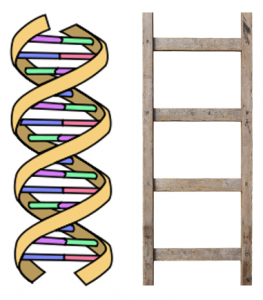DNA (deoxyribonucleic acid) is the way that living beings store the information that determines how they look and function. Think about DNA as the blueprints, or instructions, for life. All life forms – humans, cats, dogs, trees, and bacteria – all contain DNA. Your DNA is what carries the information that decides your specific traits, like what color eyes you have or if you will be tall or short. All the information in your DNA is unique to you. No one else in the world has the exact same DNA as you, unless you have an identical twin. You do share about fifty percent of your DNA with your biological parents, because the information stored in DNA is transmitted from generation to generation. This is why you look a little bit or a lot like your parents.
The reason that traits, like having blue eyes or being short, run in families is because they are transmitted in genes, which are the functional units of DNA. Genes work on a very small scale, providing instructions to the cells of your body so they know what they need to make to do their jobs. While normal changes in the DNA can influence physical characteristics, like eye color, sometimes abnormal changes in the DNA may cause individuals to develop a disease. This is the case for hereditary ataxias. The abnormal DNA changes (called “mutations”) make it so cells no longer do their jobs well. Although we live with the same DNA information all our lives, it may take years or decades for a disease to manifest. As with genes for eye color, the genes causing a disease can be transmitted across generations. This explains why families are more likely to have relatives with the same type of ataxia.

So, that is what DNA does, but what does it actually look like? DNA forms a double helix, think of it as a twisted ladder. The sides of the DNA ladder are made up of sugars, specifically “deoxyribose” units, and phosphate groups, and the rungs of the ladder are made up of bases. There are four bases, adenine, thymine, guanine, and cytosine, or A, T, C, and G for short. In the DNA ladder, each rung is made up of two bases forming a pair, either A and T or C and G. The instructions for life are “written” into our DNA using these bases, sometimes called the “genetic code”. The language of the genetic code has a lot fewer letters than our alphabet, just A, T, C, and G, but together these four bases write every instruction for every function and characteristic of every living thing that has ever existed in the form of genes.
If you would like to learn more about DNA, take a look at this BBC article.
Snapshot written by Dr. Laura Bowie, edited by Dr. Judit M Perez Ortiz.









